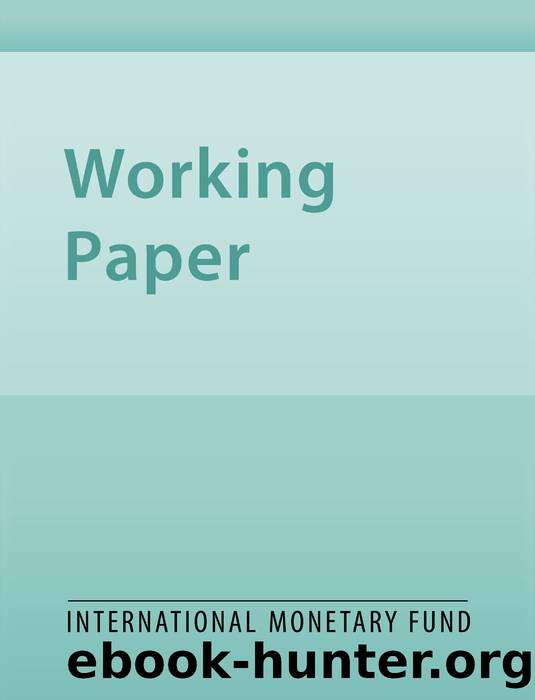Das (Wasted) Kapital: Firm Ownership and Investment Efficiency in China by David Dollar; Shang-Jin Wei

Author:David Dollar; Shang-Jin Wei
Language: eng
Format: epub
ISBN: 9781452722887
Publisher: International Monetary Fund
Published: 2007-08-15T00:00:00+00:00
The advantage of this approach is to avoid the need to assume that the production function is Cobb-Douglas and that the capital share for different firms within a sector is identical. But the advantage comes with a cost, which is to assume that wage payment is accurately observed.
Table 7 presents the summary statistics of raw . Both the mean and the median marginal returns line up in the same way across ownership as for the average returns reported earlier. In particular, the marginal returns are substantially lower for the three types of state-owned firms than for either domestic private or foreign-owned firms. The median value of marginal returns to capital for private firms (at 0.63) is 26 percentage points higher than the median value of marginal return for wholly state-owned firms (at 0.37).
The raw distributions in Table 7 do not take into account sector or location composition of the firms which could bias the comparison of the returns across ownership (e.g., state-owned firms could happen to be over-represented in sectors that have lower returns). In Table 8, a set of regressions are run that include sector*year fixed effects as well as location fixed effects. All regressions consistently show that returns are lower for state-owned firms than for private or foreign-owned firms. For example, in Column 3 of Table 8, where the dependent variable is , and the sample is trimmed for 10 percent biggest and smallest returns for each ownership type, the marginal returns to capital for wholly state-owned, majority state-owned, and minority state-owned firms are 36, 15, and 12 percentage points lower than that of private firms within the same sector and in the same city. All three coefficients are statistically significant at the 1 percent level.
In Column 6 of Table 8, where the dependent variable is ln(MRPKo), and the sample is also trimmed for 10 percent biggest and smallest returns for each ownership type, only the coefficients for wholly and majority state-owned firms are negative and statistically significant at the five percent level. As explained earlier, the coefficients can be interpreted as the added cost of capital and output distortions faced by state-owned firms relative to those faced by domestic private firms. By these point estimates, wholly state-owned and majority state-owned firms face lower costs of capital (and/or less output distortions) on the order of 50 and 18 percentage points, respectively. In other words, the constraints on private firmsâ ability to access financing (or other constraints that prevent them from taking advantage of the high marginal returns to capital) are severe.
Table 9 repeats the regressions in Table 8 with the addition of a measure of firm size by employment. The results suggest that marginal returns to capital tend to be higher in firms with more employment. After accounting for this, the conclusion regarding the return differentials across ownership remains the same: state-owned firms have systematically lower marginal returns to capital than domestic private or foreign-owned firms.
Dispersion of Factor Returns across Regions and Sectors
Under the null hypothesis of optimally
Download
This site does not store any files on its server. We only index and link to content provided by other sites. Please contact the content providers to delete copyright contents if any and email us, we'll remove relevant links or contents immediately.
What's Done in Darkness by Kayla Perrin(26784)
The Ultimate Python Exercise Book: 700 Practical Exercises for Beginners with Quiz Questions by Copy(20639)
De Souza H. Master the Age of Artificial Intelligences. The Basic Guide...2024 by Unknown(20430)
D:\Jan\FTP\HOL\Work\Alien Breed - Tower Assault CD32 Alien Breed II - The Horror Continues Manual 1.jpg by PDFCreator(20413)
The Fifty Shades Trilogy & Grey by E L James(19256)
Shot Through the Heart: DI Grace Fisher 2 by Isabelle Grey(19235)
Shot Through the Heart by Mercy Celeste(19098)
Wolf & Parchment: New Theory Spice & Wolf, Vol. 10 by Isuna Hasekura and Jyuu Ayakura(17272)
Python GUI Applications using PyQt5 : The hands-on guide to build apps with Python by Verdugo Leire(17215)
Peren F. Statistics for Business and Economics...Essential Formulas 3ed 2025 by Unknown(17058)
Wolf & Parchment: New Theory Spice & Wolf, Vol. 03 by Isuna Hasekura and Jyuu Ayakura & Jyuu Ayakura(16975)
Wolf & Parchment: New Theory Spice & Wolf, Vol. 01 by Isuna Hasekura and Jyuu Ayakura & Jyuu Ayakura(16603)
The Subtle Art of Not Giving a F*ck by Mark Manson(14574)
The 3rd Cycle of the Betrayed Series Collection: Extremely Controversial Historical Thrillers (Betrayed Series Boxed set) by McCray Carolyn(14296)
Stepbrother Stories 2 - 21 Taboo Story Collection (Brother Sister Stepbrother Stepsister Taboo Pseudo Incest Family Virgin Creampie Pregnant Forced Pregnancy Breeding) by Roxi Harding(13946)
Scorched Earth by Nick Kyme(12935)
Drei Generationen auf dem Jakobsweg by Stein Pia(11129)
Suna by Ziefle Pia(11052)
Scythe by Neal Shusterman(10524)
